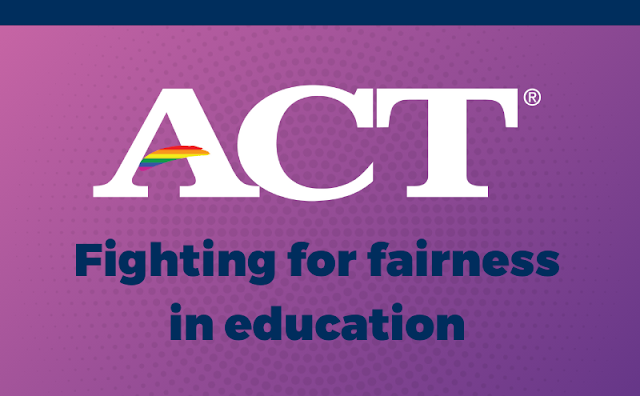
By Dr. Alex Casillas, ACT Principal Research Psychologist; Dr. Bonnie Hain, Senior Director, ACT Professional Services
“When someone with the authority of a teacher describes the world and you are not in it, there is a moment of psychic disequilibrium, as if you looked into a mirror and saw nothing.”Being a teen is hard. Teenagers are actively exploring their identity while going through a variety of physical, psychological, and social changes at the same time. Being a teen who identifies as LGBTQ+ is even harder. These teens’ needs are often overlooked—or worse yet, they may suffer more frequent micro-aggressions or bullying. So, what about being a teen who is LGBTQ+ during a global pandemic? Yes, you guessed that right: it’s likely even harder yet!
--Adrienne Rich
In fact, according to both the National Institutes of Health (NIH) and the CDC, students age 12–17 have experienced increased stress, anxiety, and depression because of the isolation brought on by the social distancing measures implemented to reduce the spread of COVID-19. Our own research tells the same story. For LGBTQ+ students, anxiety and stress may have been heightened due to losing regular access to affirming student organizations and supportive peers, teachers, and school staff during the pandemic.
So, as allies joining the LGBTQ+ community in celebrating Pride Month, we also encourage all schools to put measures in place so that every student (whether child, tween, or teen) feels safe, supported, and is able to explore and take pride in their identity.
One measure every school can put in place is a quality curriculum for social and emotional learning, beginning with our youngest students and continuing throughout a student’s educational journey. Social and emotional learning (SEL) can be an anchor during this time of intense change and instability. It underscores how each individual student has value, strengths, challenges, choices, and a vital role to play in building a positive community, whether at school, work, or at home.
According to the Collaborative for Academic, Social, and Emotional Learning (CASEL), SEL is the “process through which all young people and adults acquire and apply the knowledge, skills, and attitudes to develop healthy identities, manage emotions and achieve personal and collective goals, feel and show empathy for others, establish and maintain supportive relationships, and make responsible and caring decisions.”
SEL helps people empathize with others and celebrate the differences that make us unique. This kind of support is critical for members of marginalized groups, like students who identify as LGBTQ+.
How might we incorporate SEL curriculum into schools?
It’s most effective (for school climate, mental health, and academic performance) to embrace a whole-school focus on SEL that attempts to reach every student in every classroom. SEL tools, curricula, and assessments can be implemented as a proactive strategy in which all students engage in activities designed to build skills such as empathy, collaboration, stress management, persistence, curiosity, and many others.
For example, starting the day with brief, intentional lessons provided in an advisory or homeroom class can help students suffering from anxiety or other emotional barriers set up for a successful day of academic learning. With an effective screener assessment, SEL can also be integrated into the multi-tiered system of supports (MTSS) already in use in most districts in the United States. MTSS ensures students who need more intensive supports can receive appropriate intervention and support strategies.
MTSS and Trauma-Informed Practices
Delivering SEL programming through an MTSS approach also makes it easier to incorporate the three essential components of trauma-informed practices:
- Safety—We know that a feeling of safety at school is important for all students, but it is particularly important for LGBTQ+ students who may not feel safe in other settings that are less accepting.
- Relationships—One way to build a safe environment in school and help students who have experienced trauma is through relationships. Positive teacher-student relationships are associated with increased student engagement, attendance, and achievement. For a student with trauma, strong relationships can help them feel secure, instead of having to be “on alert,” freeing up space for them to focus on learning.
- Coping skills—Helping students develop coping skills for managing thoughts and emotions lays the groundwork for developing healthy behaviors in response to stress, nurturing supportive relationships, and cultivating the skills necessary to fulfill their potential and achieve personal and professional goals.
These are essential for those students (and adults) who have experienced trauma, but particularly for minoritized groups.
SEL can—and should—be part of every school’s toolbox for building a safe, equitable, and engaging learning environment as we emerge from the pandemic. Creating affirming policies, programs, and practices will not only help LGBTQ+ students and their peers to learn and thrive, it can help to address various forms of inequity and empower young people and adults to co-create thriving schools where they are empowered to explore their identities and contribute to safe, healthy, and just communities.
ACT fights for fairness in education and believes in providing equity, access, and opportunity for all students. We’re proud to celebrate Pride Month alongside members of the LGBTQ+ community.
Dive Deeper
Check out these resources for supporting LGBTQ+ youth:

